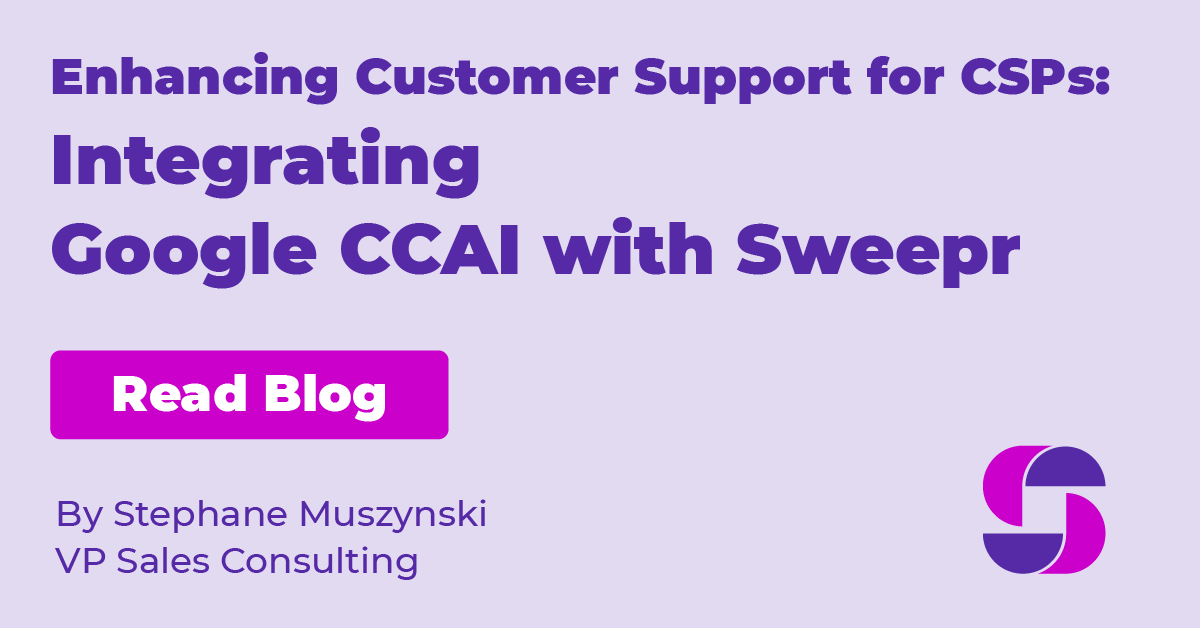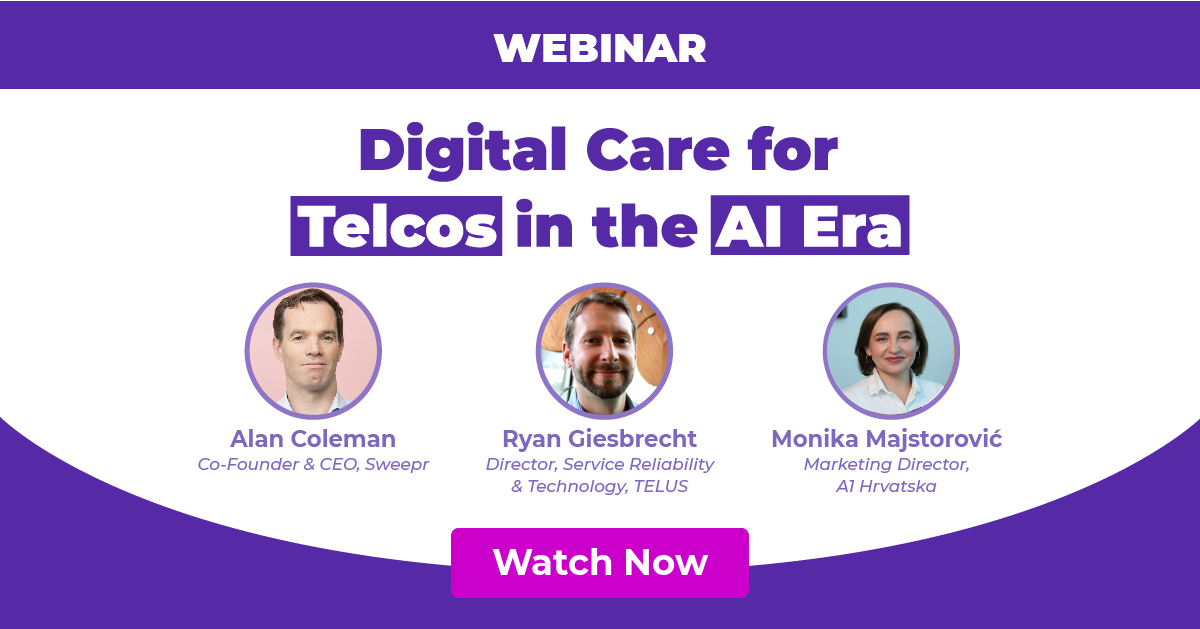Service providers are already armed with far more meaningful data points about their customers than most brands. Furthermore, observing customers’ behaviour during care interactions enables a deeper understanding. The solution to increased cross-sales through digitally automated channels is to now invest resources in a platform capable of integrating with other components in the organisation’s ecosystem, that can weave together all the data that is already available to them whilst also observing key customer context and behaviours during care interactions.
People often ask me why we started Sweepr, how we developed the core business philosophy, and what we see in the future. I hope to answer a few questions in this post, as well as give some insight into how we developed the 7 Principles of Personalisation.
We started out on this journey into hyperpersonalisation of fully-automated digital care channels a few years ago.
As entrepreneurs, Jim Hannon and I started, ran and successfully sold a business that was very much focused on customer care and empowering the customer to understand the products they were using. After our exit, we wanted to carry on working in the area of customer care, but to apply it to personalised, fully-automated digital care.
We started out on this journey into the hyperpersonalisation of fully-automated digital care channels a few years ago. Over the intervening period, we’ve researched, observed and experienced a number of consumer behaviours to build up a blueprint of what makes a truly personalised digital customer care experience: The 7 Principles of Personalisation.
As entrepreneurs, we identify where opportunity lies – where budgets are going and where pains exist.
Why fully-automated digital channels?
As entrepreneurs, we identify where opportunity lies – where budgets are going and where pains exist. Digital channels are receiving funding, but service providers are still struggling with engaging users and containing them within those channels. Why are fully-automated digital channels well accepted by customers in other industries, but not in ours?
Customers expect a higher level of care. They don’t necessarily want a relationship with their service provider, but they expect the service to work, and they want prompt, efficient and easy solutions when things fall down. At the moment, customers don’t necessarily want to call the support number, but there’s a perceived lack of trust in digital support channels that drives them to it. The reason for this is the perception of digital channels as being clunky and unintuitive – having to ask the question in a certain way to get an answer, the solutions and instructions being so standardised that they might as well be an FAQ.
Customers don’t necessarily want a relationship with their service provider, but they expect the service to work.
Humans Prefer Humans
Generally, consumers prefer talking to another human – and understandably so. Humans can intuitively sense through tone of voice and language used how the other person is feeling, their levels of understanding and engagement, and where a conversation is heading. You can explain things to a human and reason with them. You can check they understand your point and can sense nuance.
Trying to hold a conversation without understanding the facets of a person, the situation they’re in, the history of that relationship, is destined to meet with limited success or, in other words, in widespread acceptance by your customers. You can’t deliver meaningful engagement without understanding those elements.
Digital care channels don’t currently use those elements to deliver the level of sophistication consumers are expecting, which is why engagement and containment levels are so low. Although personalisation is an accepted and widely used tactic, dynamically applying real-time data and customer insights is yet to be the standard met. Digital channels would be capable of building trust with our customers, learning more about them, preventing churn and increasing cross-sales if we first invest in this approach.
Although personalisation is an accepted and widely used tactic, dynamically applying real-time data and customer insights is yet to be the standard met.
Digitally Automating Intuition Isn’t Possible
Intuition is the ability to understand something instinctively, without the need for conscious reasoning. It enables clarification and resolution. We know that intuition isn’t always possible when speaking to a care agent and it certainly can’t be digitally automated, however some of the techniques we use to ascertain intuition can be. When we analysed the drivers of a good human-to-human interaction, we saw that there were three key elements used to help guide a conversation to a successful outcome. When those providing customer services are given the opportunity to be aware of the psychology, context and history of the customer, they can adjust tone, language and advice based upon their perception and knowledge.
“Have I spoken to this person before?”
“Has the person I’m speaking to experienced this problem before?”
“Do I have the right current data to be able to help this person?”
“How engaged do they seem to be?”
“Is the way I’m explaining this solution being understood by this person?”
“Can I proactively suggest some preventative actions?”
Breaking down those conversations into component parts, we realised that we could build fully-automated digital interactions that replicate that level of rich engagement.
We worked hard to further refine and test our ideas. We formalised the three elements into the key considerations – History & Relationship, Context & Environment, and Psychology & Behavioural – and developed specific, measurable principles to sit within them.
The Birth of a Principle
We have 7 Principles of Personalisation and each of them emerged in a different way. Here are a couple of examples of how they came about.
During our conversations with users, we found out that a common point of frustration was having to explain to each care agent the issue they were experiencing – whether the agent was operating through the phone or a chat window, or if it was a chatbot. If they got cut off or passed to another agent, they would have to repeat their explanation of the issue. If the issue persisted and they had to make contact again ten minutes, ten hours or ten days later, they again had to explain the issue, the resolution offered previously and that it hadn’t worked. Often the agent would ask them to repeat the steps previously detailed, which caused frustration and reduced trust in the provider.
Consumer perception is that agents are often not considering the ways in which the same query has been dealt with previously and automated digital experiences seem to have no record of previously asked queries. We understood that giving the consumer the same resolution path, regardless of the number of times they have asked the same question, was not only frustrating for the customer, it also didn’t resolve the issue and was an inefficient use of both agent and customer time. Frustrated users feel like providers are suffering from digital amnesia. At this point, we developed the principle of Query History – the ability for a provider to enable dynamic decisioning logic dependent on the number of times the customer has asked a question.
Frustrated users feel like providers are suffering from digital amnesia.
I recall a conversation I had with Jim about the recent Facebook outage. For a significant number of people, Facebook IS the internet. It’s where they spend their time catching up with friends, playing games, watching videos and keeping up with world events. It recently saw an outage, where hundreds of millions of users across the world were unable to access their window-on-the-world. With the knowledge that this was happening, a Query Prompt could be deployed to customers through a digital support channel, who based on their previous queries or customer insights are known to be Facebook users, pre-empting support calls, letting people know that it isn’t just them experiencing the issue. This would help relieve some of the stress felt by the customer and would help reduce some of the call traffic to customer care agents.
An example of this in other sectors is when search engines pre-populate search terms in the box with ones that are typically asked. This saves the user some time, lets them know that other people are searching for similar things (and they’re not alone), and reduces the burden on the user to find the right combination of search terms.
Next Steps for the 7 Principles of Personalisation
The industry has been espousing the benefits of greater levels of personalisation for years, that it’s a meaningful exercise and they should be doing more of it, but no-one has put meat on the bones of how we can consistently build truly personalised engagements with customers. Where do you get the data from? How do you engineer that data into personalised experiences?
Our 7 Principles of Personalisation inform our platform and our platform informs organisations, enabling them to build hyperpersonalised, rich and effective interactions with customers. Those interactions affect the relationships with customers for years to come. In the industry that we work in, the longevity of those relationships is what drives trust and profitability.
Book a tour to discover how Sweepr’s 7 Principles of Personalisation help CSPs hyperpersonalise digital customer care experiences.


